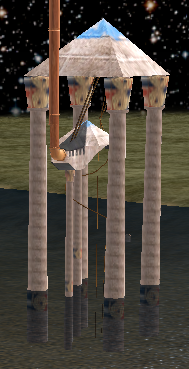The Wiki for Tale 6 is in read-only mode and is available for archival and reference purposes only. Please visit the current Tale 11 Wiki in the meantime.
If you have any issues with this Wiki, please post in #wiki-editing on Discord or contact Brad in-game.
Aqueduct Pumping Station
| English | Deutsch | français | magyar | Türkçe |

| |
|---|---|
| Size | N/A |
| Where | Aqueduct Construction Site |
Overview
Aqueduct pumps are built in an Aqueduct Construction Site. To get the aqueduct site to allow a pump to be built, run along the Nile or another deep water source with the locator window up until Aqueduct Pump is shown. Aqueduct Towers need to be built near to a Aqueduct Pump.
Building Requirements
Cost to build the pumping station:
- 600 Steel Wire for Tension Mechanism
- 600 Copper Wire for Winding Mechanism
- 120 Moon Steel Sheeting for Waterproof Sheath
- Note that the construction site claims the pump requires 120 Moon Steel, but when loading materials it will actually only accept sheeting.
- 1 Cistern
- 50,000 White Raeli Tiles
- 30,000 Greenish Raeli Tiles
- 30,000 Yellowish Raeli Tiles
- 30,000 Pinkish Raeli Tiles
- 50,000 Black Raeli Tiles
- 100,000 Any color of Raeli Tiles
- 50,000 Rotproof, Rigid, Nontoxic Boards
- 10,000 Concrete for Base
- 100 Oyster Shell Marble
- 100 Night Granite
- 100 Grey Star Marble
Filling the cistern
The pump has a cistern that holds water for distribution to towers attached to the pump. Initially, this cistern can hold up to 100,000 water.
Anyone may pump water to the pump's cistern by using the tower attached to the pump. This pumps water proportional to your STR (if you have negative STR, you cannot pump), and starts an END timer.
Each tower attached to the pump has an individual cistern that holds 2,500 units of water and fills automatically from the pump's cistern. Water in a tower's cistern evaporates at the rate of 1 water per minute (or about 1440 water per tower per day).
You can install a Springbox too, which increase the amount of Water u can pump into the Pumping Station. U can not deinstall the Springbox after installed, according to popup message.
Raising the pump
A newly constructed pump has a height of 100 feet, allowing a chain of no more than 20 towers in the best case. The pump may be raised to allow longer chains, or to cross high terrain. This is done by selecting the "raise pump" option from a tower attached directly to the pump. The upgrade requires:
- Bricks
- Concrete
- Cut Stone
- Pipe Segments
- random 2-output Gearboxes
- These gearboxes are always "split" gearboxes with one output on shaft A-C and one output on shaft F-H, so plan to use quite a few transfer gears. I averaged about 11 small, 5 medium gears per gearbox.
To raise from height h1 to height h2 requires f(h2)-f(h1) materials, where:
- fbricks(x) = x2
- fconcrete(x) = int(x2/20)
- fcut stone(x) = int(x2/75 + x)
- fpipe segments(x) = int(x/10)
- fgearboxes(x) = int(x/5)
For example, raising the pump from height 150 to height 200 requires:
- 2002 - 1502 = 17,500 bricks
- int(2002/20) - int(1502/20) = 875 concrete
- int(2002/75+200) - int(1502/75+150) = 283 cut stone
- int(200/10) - int(150/10) = 5 pipe segments
- int(200/5) - int(150/5) = 10 gearboxes
Pumps can be raised by up to 100 feet at a time. This means you can have up to 20 gearboxes to work on at once, which is useful if you have several people available to design them.
After beginning an upgrade, materials can be loaded incrementally like any other construction site. While the pump is being upgraded, the tower it is attached to cannot be raised!
Upgrading the cistern
A newly constructed pump has a cistern that holds 100,000 water. It can be upgraded in increments of 100,000.
| Capacity | Tar | Leather | Canvas | Cable |
|---|---|---|---|---|
| 200,000 | 200 | 300 | 250 | 10 |
| 300,000 | 400 | 600 | 500 | 20 |
| 400,000 | 600 | 900 | 750 | 30 |
| 500,000 | 800 | 1200 | 1000 | 40 |
| 600,000 | 1000 | 1500 | 1250 | 50 |
| 700,000 | 1200 | 1800 | 1500 | 60 |
| 800,000 | 1400 | 2100 | 1750 | 70 |
| 900,000 | 1600 | 2400 | 2000 | 80 |
| 1,000,000 | 1800 | 2700 | 2250 | 90 |